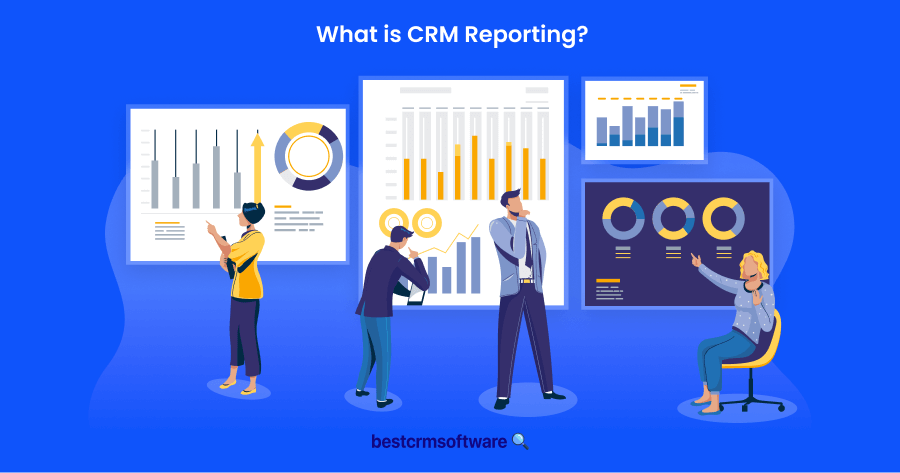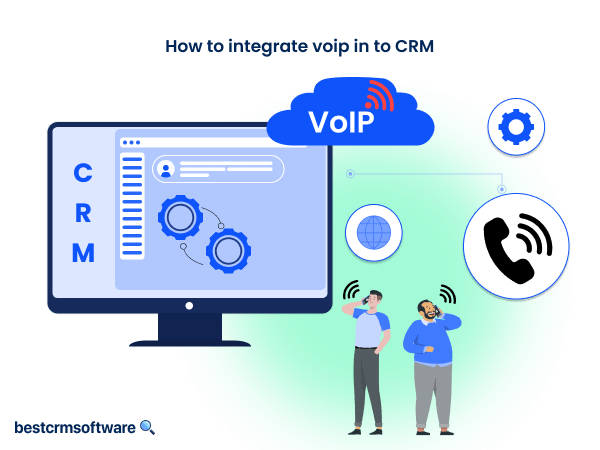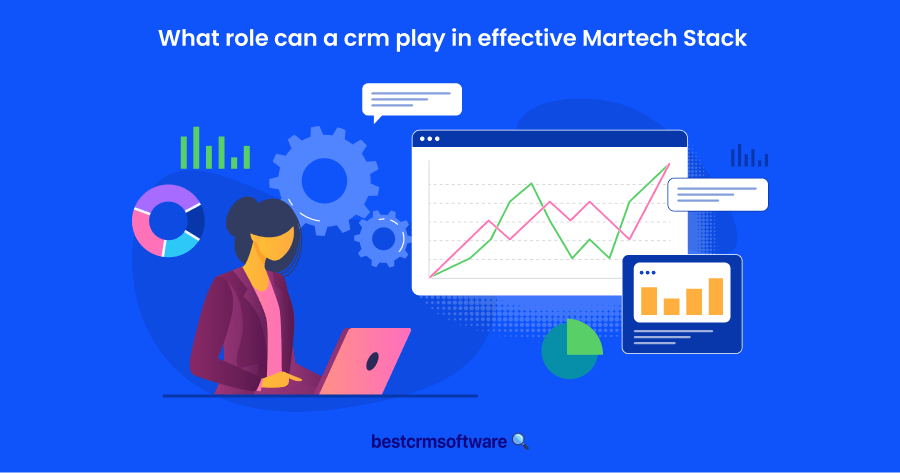
Best CRM Software for Higher Education
CRM Software for Higher Education in a Nutshell
As an educator, I see CRM software for higher education institutions as indispensable. CRM in universities and colleges manages every aspect of student life, from enrollment to alum relations. These CRMs expertly handle relationships with students, staff, and other stakeholders, streamlining complex educational ecosystems.
I went down a rabbit hole looking for the best CRM tools for higher education, and here’s my verdict on those that landed on my shortlist of 10 best CRM software for higher education.
It’s 2024, and no one can deny the overwhelming flood of data we are bombarded with daily. This data swamp is accurate for education institutes, especially in higher education. I have seen these institutes experience many hassles in student engagement, streamlining operations, and organizing vast information because they do not have the right tools. CRM software for higher education is all about taking control of this information.
9 Best CRM Software for Higher Education Shortlist
- Element451 — Best for AI-driven student engagement
- Monday Sales — Best for collaborative student management
- Slate — Best for seamless admissions processing
- TargetX — Best for holistic student lifecycle management
- Zendesk — Best for user-friendly multi-channel communication
- Zoho — Best for customizable educational workflows
- Keap — Best for automated recruitment and enrollment
- Hubspot — Best for budget-friendly comprehensive CRM
- Pipedrive — Best for visual pipeline management in admissions
Why Higher Education Needs CRM Software
In my experience, CRM for colleges and other educational institutions is irreplaceable for efficiently managing complex relationships and data, particularly as they face the challenges of increasing competition and shifting student expectations.
CRM refines admissions, increases alums and donor engagement, and improves the overall management of the student lifecycle.
These platforms address the growing need for personalized communication and rapid response to inquiries, which are becoming essential in a digitally connected world. By centralizing data access, CRM systems eliminate silos to track student progress and engagement accurately.
This capability is vital for adapting to trends like data-driven decision-making and personalized educational experiences.
Criteria for Selecting the Best CRM for Educational Institutions

Selecting the right CRM for educational institutions is essential and should be the right fit for the organization. I’ve highlighted 10 criteria to prioritize when choosing a CRM for the academic environment.
1. Customization and Flexibility
The CRM must be tailored to specific institutional needs and adapt to unique workflows, processes, and data requirements.
2. User-Friendly Interface
Emphasizes ease of use to facilitate quick adoption by staff, with minimal training required.
3. Integration Capabilities
To ensure data consistency and operational efficiency, check for effortless syncing with existing systems, such as student information systems (SIS), learning management systems (LMS), and financial management software.
4. Scalability
Assesses whether the CRM can accommodate growth in student numbers and data volume without performance drops or significant cost increases.
5. Data Security and Compliance
Ensure substantial security measures and compliance with educational data protection regulations like FERPA, including access controls and encryption.
6. Reporting and Analytics
Look for sophisticated reporting and analytics capabilities to provide insights into student demographics, enrollment trends, and campaign effectiveness.
7. Communication Tools
Evaluate the CRM’s tools for email automation, personalized messaging, and integration with communication platforms to strengthen interactions with students, alums, and stakeholders.
8. Mobile Accessibility
Consider the availability of mobile features that allow staff to access and update information remotely, ensuring responsiveness and flexibility.
9. Support and Training
Check the ongoing vendor support and training level to maximize the CRM system’s benefits and usage.
10. Cost and Return on Investment
Analyze the total cost of ownership, including implementation, licensing, and maintenance, against the expected improvements in operational efficiency, cost savings, and potential for increased enrollments.
My Top Picks: The 9 Best CRM Systems for Higher Education Institutions

Why We Like It
Element451 has proven itself paramount in higher education’s admissions and enrollment processes. Its data-driven approach impressively meets the growing demand for personalized student engagement.
What stood out to me is how Element451 utilizes AI to speed up and precision-tune the interaction with each prospective student, making the entire process feel bespoke and individualized.
Most Important Higher Education Features
AI-Powered Marketing and Automation
- Personalized Marketing Campaigns
It tailors communications based on student interactions and preferences.
- Content Creation
Utilizes AI to generate engaging content that resonates with individual prospects.
- Automation Tools
Simplifies processes like application management, reducing manual effort and saving time.
Seamless Student Engagement
- Personalized Touch-Points
From initial inquiry to final payment, ensures each interaction is customized and relevant.
- Engagement Tracking
Monitors and analyzes each step of the student journey, enhancing strategies for retention and success.
Integration with Academic Systems
- Data Consolidation
Connects seamlessly with existing systems (SIS, LMS, etc.) to ensure consistent and reliable data across platforms.
Pros
- Provides a comprehensive toolkit for managing the student lifecycle from prospect to enrollment.
- Enhances staff efficiency with powerful automation and AI features, reducing manual effort.
- Provides an aesthetically pleasing interface, improving the student’s digital interaction with the institution.
Cons
- Initial setup and customization can involve a steep learning curve.
- The breadth of features may overwhelm new users initially, though ongoing development has improved user experience significantly.
- Rapid deployment of new features requires users to adapt frequently to updates.

Why We Like It
Monday Sales CRM offers a revolutionary collaborative space that elevates how departments, programs, and student communications are managed in higher education. Its cross-functional collaborative capabilities particularly impress me, allowing staff to manage all aspects of the educational experience from anywhere.
This CRM can unify various interactions onto a single platform, proving essential for dynamic educational settings.
Most Important Higher Education Features
Advanced Communication Tools
- Email Sync & Tracking
Integrates smoothly with Gmail/Outlook for streamlined email management, automatic logging, and instant notifications.
- Mass Email Capability
Facilitates sending personalized bulk emails, significantly improving outreach efficiency.
Elevated Activity and Performance Tracking
- Activity Management
Keeps a detailed log of calls, meetings, and notes, ensuring all communication is clearly documented and easily accessible.
- Sales and Performance Dashboards
Delivers instant insights into deal progress, sales figures, and team performance metrics.
Efficient Data Organization and Access
- Data Integration and Management
It simplifies merging new and existing data, eliminating duplicates, and organizing information centrally.
- Mobile Accessibility
Ensures comprehensive CRM functionality on the go with powerful mobile apps for iOS and Android.
Strategic Automation and Integration
- Automation Tools
Minimizes manual tasks with customized automation, freeing up time for strategic activities.
- Extensive Integrations
Connects with over 72 third-party apps, enhancing CRM functionality and ensuring data uniformity.
Pros
- Centralized management of data and communications helps refine administrative tasks.
- The interface is intuitive, with customizable workflows that cater to various administrative needs.
- Advanced analytics provide deep insights into operations and outcomes.
- Mobile capabilities ensure accessibility and functionality anywhere.
Cons
- The initial setup and customization may require a dedicated effort to optimize system effectiveness.
- The broad array of features may initially overwhelm new users.
- Full system benefits depend on careful integration setup to fully utilize the platform’s capabilities.

Why We Like It
Slate by Technolutions has carved out a unique space as a CRM specifically crafted for admissions and enrollment processes in higher education.
What impresses me most is its ability to precisely handle every part of the student engagement cycle, from initial application to fostering lasting alums and donor relationships. It integrates with significant education applications like Banner and PeopleSoft.
Most Important Higher Education Features
Comprehensive Integration
- Broad Compatibility
Works seamlessly with leading higher education systems, including Banner, Colleague, and PeopleSoft.
- Sophisticated Document Management
Manages file-types like PDFs, videos, and audio seamlessly within the application process.
Advanced Communication and Engagement Tools
- In-depth Communication Tools
Includes advanced texting features and video integrations for dynamic interactions.
- Payment Integration
Facilitates smooth processing of payments within the platform, enhancing convenience for users and administrators.
Security and Data Management
- Industry-Leading Security
Offers top-tier security options to protect sensitive information effectively.
- Data Exploration and Reporting
Features like the Data Explorer allow deep insights into analytics and reporting, enabling targeted and strategic decision-making.
Pros
- Highly comprehensive, managing all aspects of the student lifecycle effectively.
- Offers unmatched customizability to tailor features to the specific needs of any institution.
- Integrates smoothly with various educational software, enhancing functionality and user experience.
Cons
- Some users find the interface to include excessive scrolling and need more shortcuts, which can be time-consuming.
- The platform’s unique jargon can create a learning curve for new users unfamiliar with the terminology.
- Social features may need to be more utilized or clarified in their application within an admissions-focused CRM.
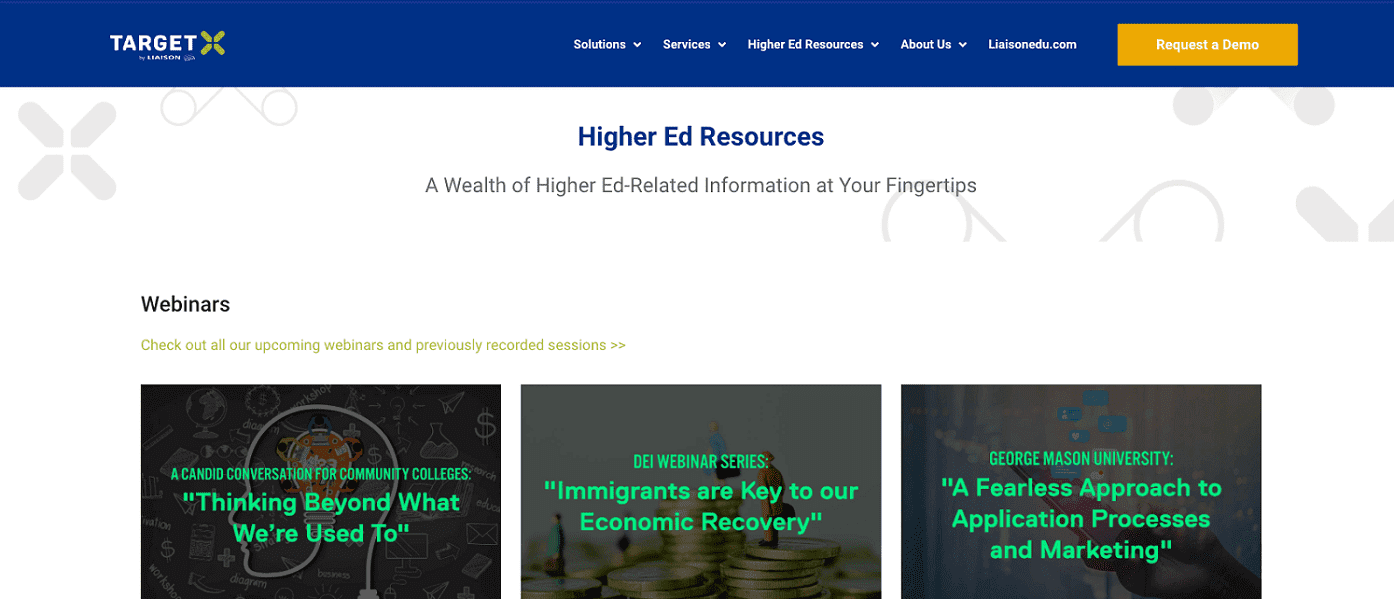
Why We Like It
TargetX emerges as a full-scale CRM solution for higher education institutions looking to manage the entire student lifecycle. What sets TargetX apart for me is its division into specialized suites, such as the Enrollment Suite and Retention Suite, which cater to distinct needs within the educational framework.
The CRM’s ability to connect seamlessly with tools like Salesforce bolsters its versatility.
Most Important Higher Education Features
Diverse Functional Suites
- Enrollment Suite
Optimizes the recruitment and admissions processes.
- Retention Suite
Aims to boost student retention through enhanced engagement and support.
- Community College Suite
Meets the distinct requirements of community college students, promoting inclusivity and success.
Enhanced Communication and Data Tools
- UChat
Engages prospective students via a live chat widget in real-time, increasing conversion rates and enhancing information accessibility.
- TargetX Insights
Leverages advanced analytics to drive strategic decision-making across the student lifecycle.
Streamlined Process Management
- Mobile-first Tools
Prioritizing mobile access is crucial for modern students and busy campus administrators.
- TargetX Engage
Manages walk-in appointments skillfully, boosting staff productivity and student satisfaction by reducing wait times.
Pros
- Provides a student-centric, one-stop-shop CRM experience that simplifies and personalizes student interactions.
- Supports a wide range of processes from recruitment to alum engagement, all underpinned by reliable analytics.
- Flexible and highly integrative with primary educational tools and platforms.
Cons
- The recent acquisition by Liaison has led to decreased customer support quality concerns.
- Native SMS features are limited, which may affect communication efficiency.
- Transitioning from third-party products to internal solutions like TargetX Print has seen a dip in functionality, affecting user experience.

Why We Like It
Zendesk for Education tackles the modern challenges that educational institutions face, such as adapting to remote learning, managing tighter budgets, and meeting increased demands. I find its platform notably user-friendly, enabling smooth communication across multiple channels like email, chat, phone, and social media without heavy IT support.
The swift setup and minimal maintenance requirement make it highly attractive for educational settings.
Most Important Higher Education Features
Integrated Communication Channels
- Ensures staff can interact with students and parents through their preferred platforms, such as email, social media, or messaging apps.
Self-Service Knowledge Base
- Allows easy creation and distribution of help center articles, aiding staff in efficiently managing frequent inquiries and updates.
Efficient Support Management
- Features like AI-powered automation and ticketing systems optimize the resolution process, enhancing the overall responsiveness of educational support teams.
Pros
- Facilitates collaboration among support staff with tools that effectively manage multiple agents and permissions.
- Offers a robust ticketing system with configurable views and essential markdown support to track and solve issues.
- Quick deployment enables institutions to focus more on educational goals and less on administrative setup.
Cons
- Frequent UI updates can disrupt productivity as staff adjust to the new interface.
- The search functionality lacks advanced features, which limits effectiveness in resolving specific queries.
- The billing model is rigid, causing frustration as it does not allow customization of packages to exclude unneeded features for cost efficiency.
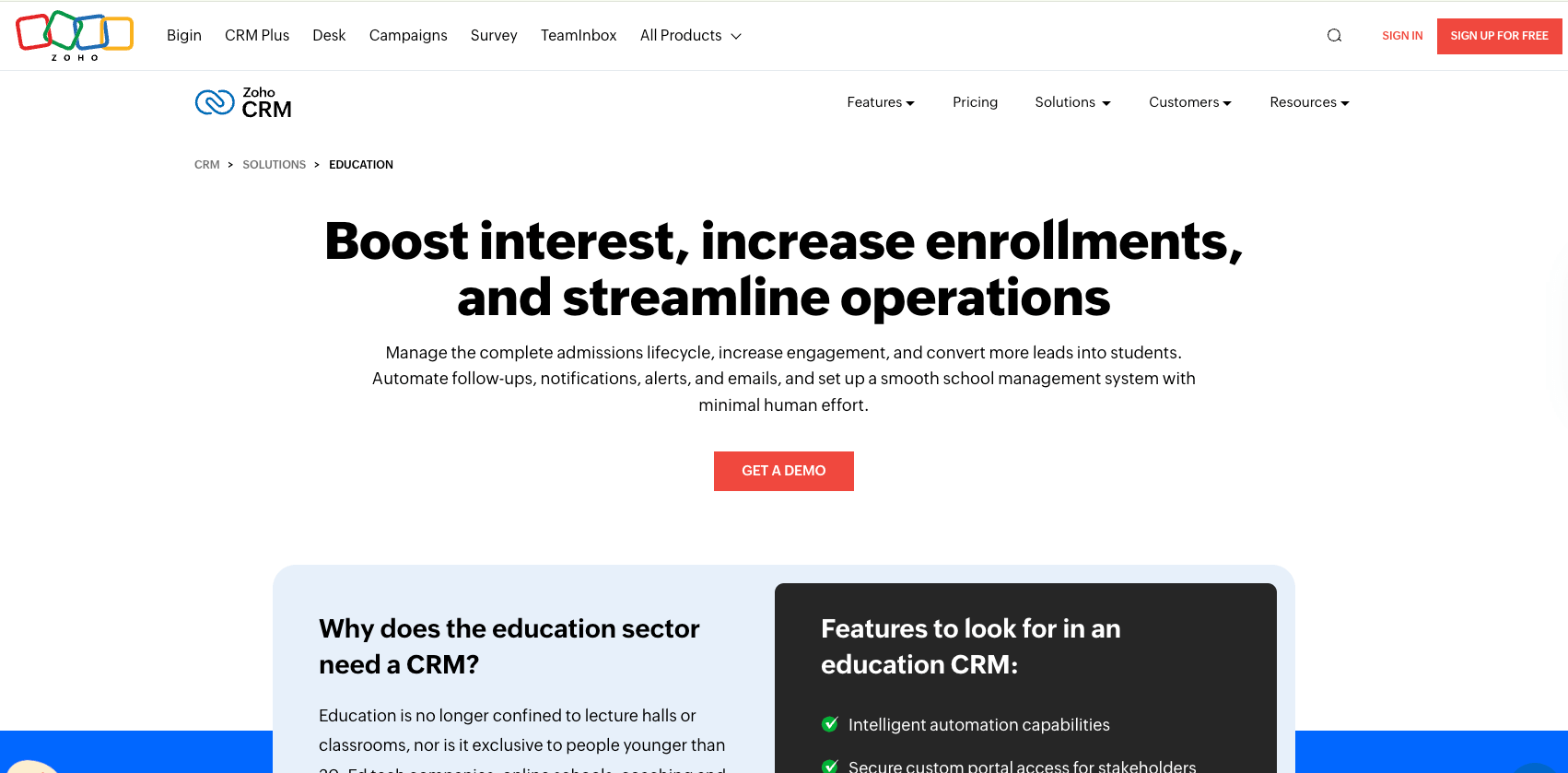
Why We Like It
Zoho CRM distinguishes itself for its adaptability and ease of use, crucial in the ever-evolving educational sector. While not exclusively an education CRM, its ability to activate features tailored for education—like custom modules for student data management—makes it incredibly effective for schools and universities.
I appreciate how it combines simplicity, affordability, and broad customization to suit the particular requirements of CRM educational institutions.
Most Important Higher Education Features
Educational Sector Customization
- Allows activation of features tailored specifically to manage student data and educational workflows.
Comprehensive Integration Capabilities
- Securely integrates with widely used apps and platforms, enhancing functionality without extra IT overhead.
Automation and Analytics
- Offers robust automation and comprehensive analytics to streamline operations and foster data-driven decision-making.
Pros
- Includes a free plan, providing cost-effective access for educational institutions of varying sizes.
- Automation is included across all plans, improving operational efficiency.
- Supports extensive integrations and comes equipped with a mobile app for accessibility anywhere.
- Provides a 45-day money-back guarantee, ensuring institutions can trial its features risk-free.
Cons
- Advanced AI features are only available on the higher-tier plans, which may be a limitation for smaller institutions.
- Custom field options are limited, which can be restrictive for managing complex educational data.
- The free plan does not have integration capabilities, which may hinder seamless functionality for institutions that are not ready to commit to paid plans.
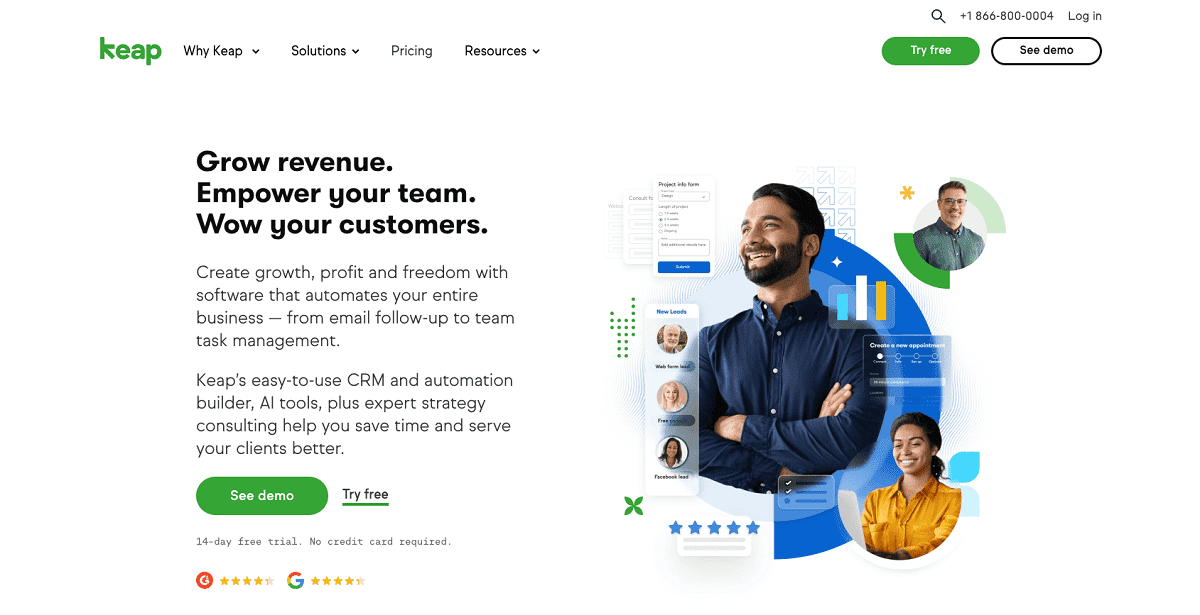
Why We Like It
Keap appeals to me due to its strong focus on automating and optimizing sales and marketing processes, which translates well into the needs of higher education institutions managing outreach, recruitment, and enrollment.
While Keap is traditionally used by small businesses, its ability to create customized pathways and maintain crucial touch points throughout the student journey can significantly enhance a university’s engagement and conversion efforts.
Most Important Higher Education Features
Automated Lead Capture
- Collects prospective student data effectively from various channels such as landing pages, contact forms, and social media.
Segmentation and Personalized Automation
- Allows personalized communication by triggering automation based on student data and engagement, which helps tailor the outreach to individual needs.
Centralized Data Storage
- Keeps all essential data in one accessible location, available via both desktop and mobile applications, ensuring that staff can reach information swiftly and on time.
Pros
- Customizable to fit the specific processes of higher education institutions.
- Integration capabilities with tools like Zapier improve functionality and extend the platform’s utility.
- Robust reporting features provide valuable insights into campaign effectiveness and student engagement.
Cons
- The platform can be complex, requiring significant time to understand and fully utilize its extensive features.
- Customer support quality could be improved, with some users reporting communication and problem-resolution challenges.
- Integration with external platforms may experience disruptions, especially following updates or changes to third-party services.

Why We Like It
HubSpot CRM is convenient for schools managing tight budgets because it offers a comprehensive CRM platform at no cost. This affordability is particularly beneficial for smaller schools or departments.
With unlimited users and no expiration date, HubSpot makes it easy to centralize data with tools such as email tracking, live chat, and meeting scheduling, making it accessible and efficient for educational settings.
Most Important Higher Education Features
Comprehensive Data Management
- HubSpot allows unlimited data storage and manages up to 1 million contacts, which is ideal for extensive educational networks.
Communication Tools
- Features include email tracking, live chat, and a meeting scheduler to boost communication with students, parents, and staff.
Real-Time Analytics
- The platform’s visual dashboard provides a clear view of sales and engagement activities, helping schools gauge the effectiveness of their outreach and operational efforts.
Pros
- Offers reliable support with quick and helpful feedback.
- Accurately records and organizes information, enhancing data reliability.
- The integrated calendar tool efficiently manages scheduling for various school activities.
Cons
- Limited customization options for the interface, reporting, and analytics can restrict the ability to tailor the CRM to specific educational needs.
- The email system lacks advanced threading options, complicating email sequence management.
- The absence of features like a mass change function for task dates limits the CRM’s more extensive scale outreach functionality.

Why We Like It
Pipedrive is remarkable for its user-friendly interface and intense focus on sales process automation. It can be particularly beneficial for educational institutions looking to boost admissions and manage extensive outreach campaigns.
I appreciate how Pipedrive prioritizes activity management, enabling staff to effectively organize and track interactions related to student applications, enrollment, and retention.
Most Important Higher Education Features
Automated Lead Capture
- Efficiently gathers prospective student information from various channels, reducing manual data entry and increasing accuracy.
Pipeline Management
- This system utilizes a Kanban-style dashboard that visually tracks the progress of admissions and other financial activities, making it easy to see where each prospect stands.
Mobile Accessibility
- The company offers a robust mobile app that ensures staff can access crucial data and perform tasks from anywhere, essential for agile, responsive interactions.
Pros
- Visual pipeline management helps schools visualize and manage their admissions process from start to finish.
- The free trial allows institutions to explore features before committing financially, reducing upfront risks.
- Known for its simplicity and effectiveness, which helps optimize processes and minimize the necessity for extensive training.
Cons
- The platform offers limited customization options, which may not meet the specific needs of all educational programs.
- User feedback indicates occasional technical glitches and stability issues, which can hinder access to the CRM when constant availability is critical.
- The initial setup and creation of custom filters can be challenging for beginners, potentially requiring additional support or training.
Choosing the Right CRM for Higher Education
I found that identifying the right CRM system is essential for effectively managing student data and enhancing engagement within educational institutions. The best CRM solutions for academic institutions provide flexibility, comprehensive analytics, and user-friendly interfaces to support schools in achieving their administrative and engagement goals.















